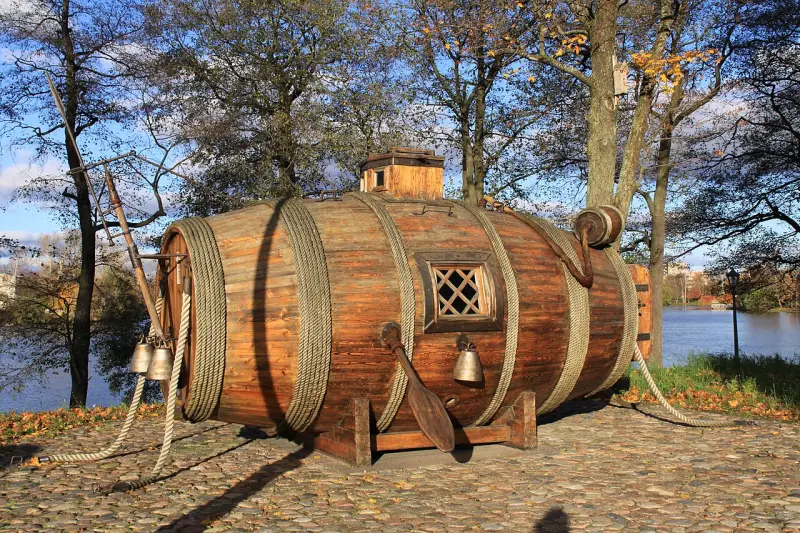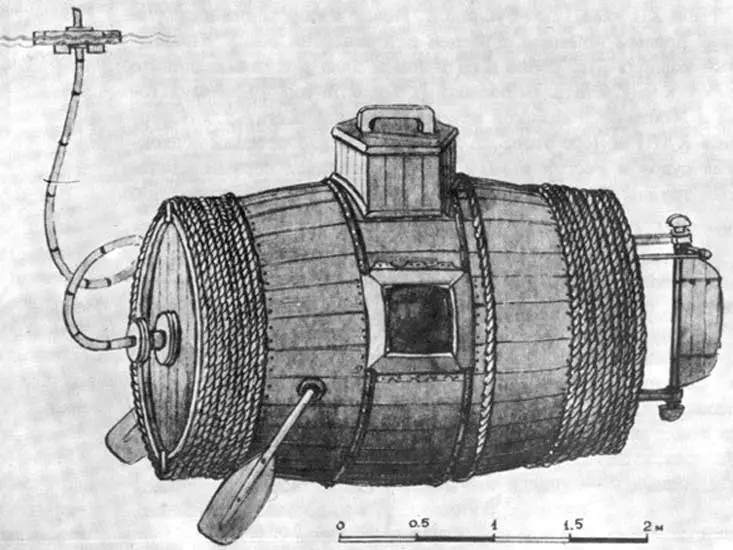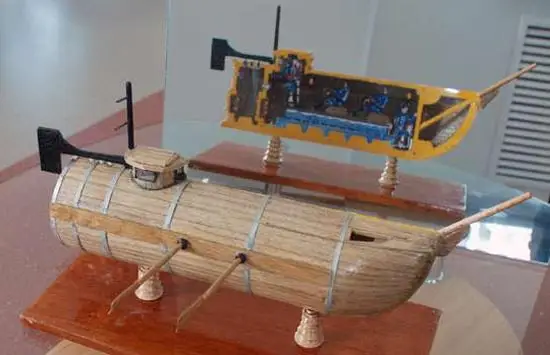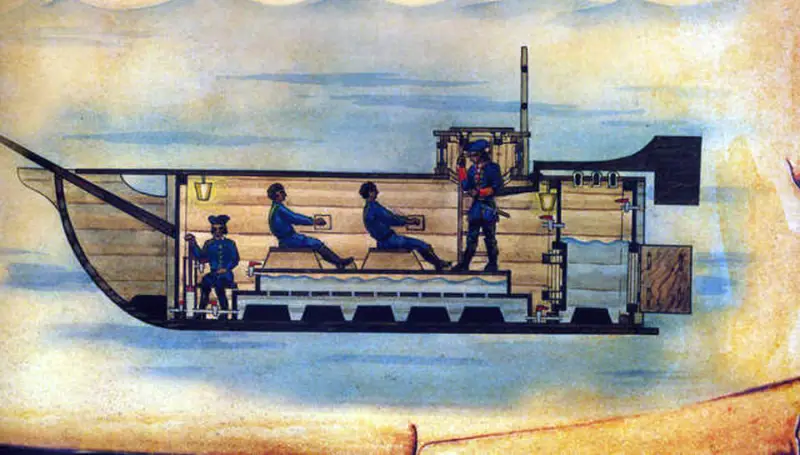The secret ship of Efim Nikonov: technology, failure and useful experience

Modern reconstruction of the hidden ship of E. Nikonov in Sestroretsk. Photo: Wikimedia Commons
Next fall marks the 300th anniversary of the start of testing of the first Russian submarine - a “hidden vessel” designed by carpenter Efim Prokopyevich Nikonov. At one time, this project did not produce real results and remained in the category of technical oddities. However, he took his place in stories domestic shipbuilding, and also showed the fundamental possibility of solving complex engineering problems with limited technological capabilities.
Initiative from below
The history of the first domestic submarine began in 1718, when a carpenter of peasant origin, E.P. Nikonov from a village near Moscow sent a petition to Tsar Peter I with an original idea. Nikonov proposed building a special vessel capable of moving underwater and covertly inflicting damage on enemy ships. Moreover, he was ready to take on the construction himself.
The first letter remained unanswered, but in 1719 Nikonov again turned to the tsar. This time Peter the Great became interested in the new idea and summoned the inventor to the capital. After reviewing the proposal in detail, the king gave the go-ahead for its implementation. At the same time, he demanded to start with a large-scale technology demonstrator model.
In January 1720, the carpenter Nikonov was appointed master of hidden ships and sent to the Ober-Sarvaer shipyard in St. Petersburg to carry out construction. A team of shipbuilders was assembled and the necessary materials were allocated. The development and construction of a model of an underwater vessel began in February of the same year and was completed in March 1721.

"Barrel-shaped" version of the vessel in a submerged position. Wikimedia Commons Graphics
In the summer, demonstration tests of a model of a secret vessel were carried out in one of the water areas near the capital. The product showed the ability to dive, surface and move. At the same time, some design flaws were identified. Tsar Peter generally approved the project and ordered the construction of a full-size vessel to begin.
First submarine
They decided to build a full-fledged secret vessel, controlled by a crew and suitable for solving combat missions, at the Galernoy Yard of the Admiralty in St. Petersburg. Construction began in August 1721 and was carried out secretly. In particular, a kind of workshop was erected specifically for assembling the secret structure. The necessary resources were allocated - boards, metal raw materials, canvas, etc.
In parallel with the construction of the ship, E. Nikonov and colleagues were engaged in the manufacture of special suits for its crew. From a certain time, the design of a secret ship provided for the possibility of sailors leaving the hull to carry out attacks and sabotage. To do this they needed the appropriate equipment.
The construction of the experimental secret vessel took a little more than three years. Only in the early autumn of 1724 was it allowed to be launched for testing. Almost immediately after the descent, the crew under the command of Master Nikonov himself began diving. According to various sources, the tests were carried out on the river. Neva or on the river. Sister or on the lake Sestroretsky Razliv.
The experimental vessel demonstrated the ability to dive and surface. According to some sources, they managed to demonstrate movement under water. However, during one of the first dives, the ship hit the bottom and was damaged. He was brought to the surface in time and the crew was saved. Despite the accident, Peter I ordered repairs and continued testing.

Another option for reconstructing the appearance. Photo: Deepstorm.ru
In the spring of 1725, the ship was re-launched, but a leak was discovered, and the prospects for testing were again in question. In addition, Tsar Peter had passed away a few weeks earlier, and the project was virtually left without support. Because of this, new improvements took several years. The last attempt to conduct tests took place in 1727, and also did not produce any results.
The following year, the Admiralty ordered the work to be stopped. For 10 years, it was not possible to build not only a full-fledged operational vessel, but also a normal operating model. At the same time, valuable resources were spent on the project. Further efforts in this direction were considered futile. E. Nikonov was demoted to ordinary carpenter and sent to the shipyard in Astrakhan. At this point, his traces are lost. The secret vessel, built but not properly tested, was hidden in a barn. It stood there for several years until it rotted.
Technical puzzles
Historical documents preserve basic information about construction and tests carried out, resources expended, etc. However, there is no complete description of the hidden vessel or its model, as well as reliable images of them. Apparently, the construction was carried out without proper design documentation, and the finished product was not sketched due to secrecy. In addition, drawings or drawings, if they existed, may have been lost over time.
However, attempts have been made repeatedly to restore the possible appearance of Nikonov’s vessel. Such reconstructions are based on lists of resources used, various points and nuances of surviving reports, etc. A number of museums have models of submarines made using such reconstructions.
For the construction, master Nikonov was provided with significant quantities of pine boards, metal strips, copper wire, ropes, canvas, resin, etc. Later, as the project developed, its author demanded the provision of additional materials and products of a different kind. Carpenters and, according to some sources, coopers also took part in the work.

Sectional view of the ship. Graphics Triptonkosti.ru
According to the widespread version, based on information about the involvement of coopers, the hull of the hidden vessel was made in the form of a large barrel. It was assembled from separate boards, tied together with metal strips and secured with ropes. The bow and stern ends were formed by two round covers. There is a version of a similar, but more complex design. Thus, the main part of the hull could be made in the form of a cylinder, tightened with hoops, and the nose had a more complex “ship” shape.
E. Nikonov came up with an original ballast system. It is known that its main element was the so-called. water box. To receive seawater, the ship used a device in the form of several tin plates with a large number of small holes. The exact design and operating principle of the ballast system is unknown. The tank box probably had pipelines for supplying water and releasing air. In this case, plates with holes limited the rate of water flow and served as a filter. A hand pump could be used to discharge ballast. Modern type blowing was hardly possible.
Oars, brought outward using flexible sealed connections, could be used as propulsion. At the same time, one did not have to count on high driving characteristics, and reaching the target could take a lot of time.
As development and construction progressed, the composition of the hidden ship’s weapons and methods for solving combat missions were revised several times. At first, Nikonov proposed equipping the ship with small-sized and small-caliber artillery. Then he emphasized secrecy and proposed sabotage. In this case, the crew of the ship in special suits had to leave the ship through the airlock chamber and, using various tools, cause damage to the surface part of the enemy ship.
The latest version of the project proposed the use of flamethrower-incendiary weapons in the form of copper pipes with a pyrotechnic composition. In this case, the secret ship could covertly approach the target ship and set it on fire.
The most general description of a diving suit for “combat swimmers” has been preserved. Its main part was made of yukhot leather (yuft), and the helmet was made in the form of a wooden barrel of the appropriate size with small eyepieces. The holes were sealed with lead plugs. Ballast was also provided in the form of lead or sand on the back.
Available technologies
In general, the project of Efim Nikonov’s secret ship cannot be called unambiguous. On the one hand, it was one of the first submarines in history capable of moving underwater and performing combat missions. On the other hand, the ship failed the tests - due to design flaws or other reasons. Perhaps, with a more in-depth study of the project and further improvement of the design, Nikonov or other domestic shipbuilders would be able to make a full-fledged combat-ready submarine.
However, it should be remembered that the secret ship was created three centuries ago. At that time, underwater shipbuilding simply did not exist, and no one had the necessary knowledge and experience. In addition, there were known limitations in materials and manufacturing techniques. If we take into account all these factors, then the project of E.P. Nikonov, despite the general failure, looks more interesting from a technical and historical point of view.
Information